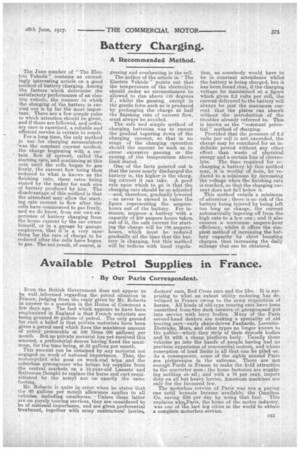Battery Charging.
Page 11

If you've noticed an error in this article please click here to report it so we can fix it.
A Recommended Method.
The June number of "The Electric Vehicle" contains an exceedingly interesting article on a good method of battery charging. Among the factors which determine the satisfactory performance of an electric vehicle, the manner in which the charging of the battery is carried out is by far the most important. There are a few simple rules to which attention should be given, and if these are followed, and ordinary care is exercised, a reliable and efficient service is certain to result.
For, a long time, the only method in use for charging accumulators 'was the constant current method, the charge beginning with a certain flow of current, called the starting rate, and continuing at this rate until the cells began to gas freely, the current flow being then reduced to what is known as the finishing rate, these rates being stated by the maker for each size of battery produced by him. The disadvantage of this method is that the attendant may allow the starting rate current to flow after the cells have commenced to gas freely, and we do know, from our own experience of battery charging from the house current by the ear owner himself, or in a garage by 'garage employees, that it is a very rare-thing for the rate of charge to be reduced after the cells have begun to gas. The net result, of course, is gassing and overheating in the cell.
The author of the article in "The Electric Vehicle" points out that the temperature of the electrolyte should under no circumstances be allowed to rise above 110 degrees F., whilst the gassing, except in the gentle form such as is produced by prolonging the charge at half the finishing rate of current flow, must always be avoided. The safe and simple method of charging batteries was to ensure the gradual tapering down of the charging current, so that in no stage of the charging operation should the current be such as to –cause excessive gassing or the raising of the temperature above limit stated.
One of the facts pointed out is that the more nearly discharged the battery is, the higher is the charging , current it can take. A good rule upon which to go is that the charging rate should be so adjusted —and, therefore, gradually lowered --as never to exceed in value the figure representing the amperehours out of the battery. For instance, suppose a battery with a capacity of 250 ampere hours taken_ out of it, the safe current for starting the charge•will be 180 amperehours, which must be reduced gradually all the time that the battery is charging, but this method will be tedious with hand regula tion, as somebody would have to be in .constant attendance whilst the battery is being charged, but it has been found that, if the charging voltage be maintained at a figure which gives 2.3 volts per cell, the current delivered to the battery will always be just the maximum current that the plates can absorb without the introduction of the troubles already referred to. This is known as the ",coeistant potential" method of charging.
Provided that the pressure of 2.3 volts per cell is not exceeded, the charge may be contiAued for an indefinite period without any other effect than waste of electrical energy and a certain loss of electro
lyte. The time required for recharging a battery by this method may, it is worthy of note, be reduced to a minimum by increasing the voltage when the finishing rate is reached, so that the charging current does not fall below it.
This method entails 'a minimum of attention ; there is no risk of the battery being injured by being Left too long on charge, the current automatically tapering off from the high rate to a low one ; and it also ensures a maximum ampere-hour efficiency, whilst it offers the
sini
plest method of increasing the battery capacity by short boosting charges, thus increasing the daily mileage that can be obtained.




















